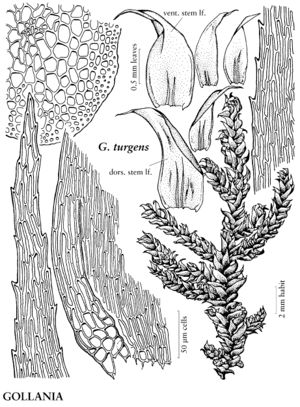Gollania
in H. G. A. Engler and K. Prantl, Nat. Pflanzenfam. 231[I,3]: 1054, fig. 755. 1908.
| Taxon | Illustrator ⠉ | |
|---|---|---|
 | Gollania turgens | Patricia M. Eckel |
Plants moderately large, densely caespitose, golden yellow to golden brown, somewhat glossy. Stems creeping, densely or rarely loosely pinnate; hyalodermis absent, central strand present, weak; pseudoparaphyllia foliose, lanceolate, never filamentous. Stem and branch leaves with dorsal, lateral, and ventral stem-leaves often different in shape and size. Stem-leaves closely imbricate, narrowly lanceolate, plicate; base not or short to long-decurrent; margins recurved at base, entire to subentire proximally, serrate, serrulate, or rarely entire distally; apex narrowly acute [blunt]; costa double; alar cells differentiated, subquadrate to rectangular; laminal cells smooth, walls thick; medial cells linear. Branch leaves much smaller, narrower. Specialized asexual reproduction absent. Sexual condition dioicous; inner perichaetial leaves oblong-lanceolate, apex filiform-acuminate. [Seta reddish-brown. Capsule inclined to horizontal, ovoid to cylindric, straight or weakly curved, not or weakly contracted below mouth; annulus little differentiated; operculum conic, sometimes short-rostrate; peristome double; exostome teeth with external surface transversely smooth to striolate proximally, papillose distally; endostome basal membrane 1/2 exostome teeth length, segments keeled, cilia 2–4. Calyptra naked. Spores rounded, finely papillose].
Distribution
nw North America, Asia (Bhutan), Asia (China), Asia (India), Asia (Indonesia), Asia (Japan), Asia (Korea), Asia (Nepal), Asia (Pakistan), Asia (e Russia), Asia (Taiwan), Pacific Islands (Philippines)
Discussion
Species 20 (1 in the flora).
Selected References
None.